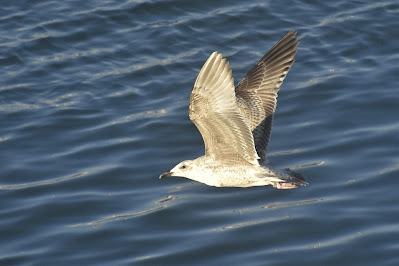This long weekend has been a busy one, with various group members (and even a visitor from up-country) heading out to all parts of West Cornwall in search of (mostly) seabirds.
We started off with our annual gull-ringing trip over to Mullion Island, which was always going to be an unknown as we were too busy colour-ringing Cormorant chicks on our last visit to count the Great Black-backed Gull nests. We headed over in two kayaks and a dinghy, landing in a quiet cove and heading onto the top of the island. Working our way round we ringed just 10 chicks, but at least another 10 were too big to try to catch. Whilst there, we were also able to photgraph a couple of ringed adults, both of which had been ringed as chicks in 2016 but are now breeding on the island. Interestingly, one (L:CN5) had been ringed as a chick on Looe Island, but has been seen a few times around Lizard and Coverack since.
Next stop was a tour of Barn Owl sites around the Lizard, ringing chicks at 10 sites in total. Several of these later broods had just two chicks, in contrast to those earlier in the season that had three or even four chicks.

Back on the seabird theme, the next day found us Kittiwake ringing at Trewavas Head. Half of the team paddled round from Porthleven while the other half walked in with a ladder from Rinsey. We all reconvened at the cliffs to scramble down and kayak round to the main Kittiwake site. With very few birds successfully breeding, we only colour-ringed eight chicks, but at least this is better than the zero of the last two years. We also took the opportunity to read various colour rings at Trequean zawn and also managed to get photographs of two metal-ringed birds. One of these (ET44236) was ringed on the Isles of Scilly in 1999 and had been seen by us at the engine houses colony in 2018 as well, so is a healthy 22 years old now. The other rewmains a mystery at the moment, with the BTO team looking at the possible options for us of what might be a very old bird!



After an extra couple of owl boxes, we then headed down to Porthgwarra for dusk to set nets for Storm Petrels. This is often the busiest month for Stormies and true to form the first net round before midnight saw 45 birds in the nets, so it was a busy session for everyone. In total we ringed 95 birds, with recaptures of a French-ringed bird and others ringed on the Calf of Man (in August 2020), St David's, Pembrokeshire (in July 2020) and one of our own from Lizard (ringed in July 2020). Talking of Stormies, we also heard from the BTO that a bird we ringed at Lizard in August 2020 was recaught on Alderney, Channel Islands on 10th July.
So al in all a very productiove weekend of seabird ringing, contributing to our ongoing colour-ringing projects for some of these species.































